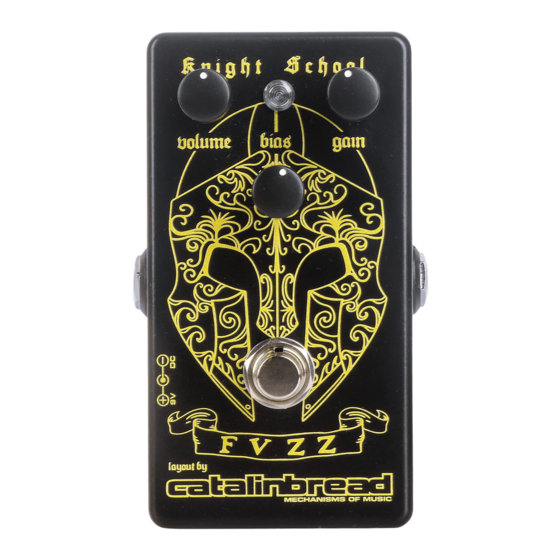
Advertisement
Advertisement
Table of Contents

Subscribe to Our Youtube Channel
Summary of Contents for Catalinbread Knight School FUZZ kit
- Page 2 AND BEFORE WE GET INTO IT: Neither I nor Catalinbread, LLC, will be held responsible for any personal harm, property damage, or any other kind of liability stemming from the assembly of this device from instructional materials found on this site or elsewhere.
- Page 3 SOLDERING: QUICK AND DIRTY Before we start, I want to say that there are plenty of fine videos on YouTube that can cover this in great detail. However, in the interest of space, I will keep it quick. 1. Whatever solder type you are using will dictate the temp at which you should run your iron. If you’re using leaded (standard) solder, you can keep it between 600 and 650 degrees.
- Page 4 PARTS LIST knobs (3) 2n5088 transistor (1) 1N4001 1N4148 diode (1) diode (2) circuit board (1) ground spring (1) DC jack (1) 100n cap. (1) cap. (2) backplate screw s (4) 2N2907A transistor (1) B100K pot. (1) LED (1) cap. (1) A100K pot.
- Page 5 ASSEMBLY INSTRUCTIONS Generally speaking, when I’m assembling a board, I install components by height, so that when I flip the board over to solder the components, the board is relatively flat on my workspace, and then I don’t have to use a third hand/PCB vise. In many cases, this means that resistors and diodes are first, any ICs/chips are second, non-electrolytic capacitors are third, transistors are fourth, elec- trolytic capacitors are fifth, and potentiometers/hardware are last.
- Page 6 3. Insert the capacitors into their indicated positions and bend the leads out. Solder them in and trim off the excess. The orientation of the non-electrolytic capacitors on the board does not matter. Capacitors are technically measured in Farads, but we work with very small values, typically in picofarads (p, pF), nanofarads (n, nF) and microfarads (u, uF).
- Page 7 ISSUE: LOUD, SOUNDS “OFF”, NOT MUCH FUZZ Potential problems: Transistors backwards, wrong parts in pads, 1N4148 diodes not inserted correctly. Solutions: Verify the placement of each part and ensure they match the board footprint. Other issues? Email us! help@catalinbread.com...















Need help?
Do you have a question about the Knight School FUZZ kit and is the answer not in the manual?
Questions and answers